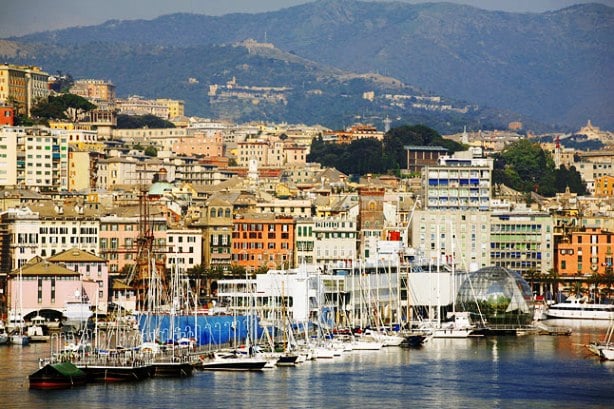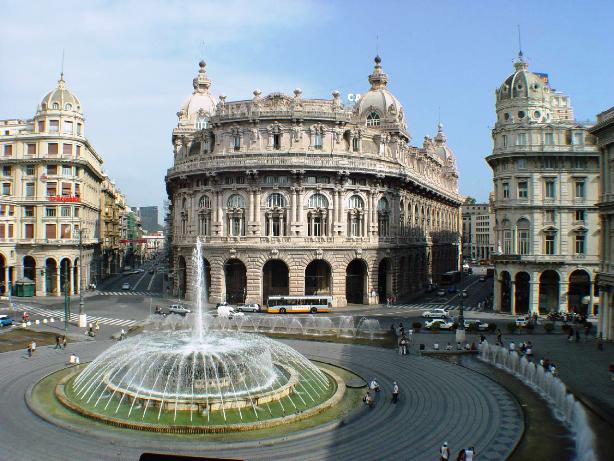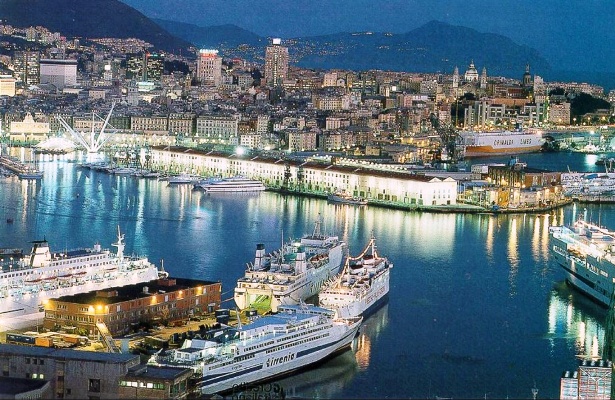If you are looking for a European tourist destination, consider the Liguria region of northern Italy, commonly known as the Italian Riviera. This thin strip of land lies on the Ligurian Sea, not far from Monaco and the French Riviera. While Liguria is by no means undiscovered, its crowds are much smaller than those next door. This beautiful region is home to many little towns or villages, and the international port city of Genoa almost smack dab in the center of the coast. This sometimes beautiful, sometimes ugly city of about six hundred thousand calls itself La Superba (the Proud). Be sure to read the other articles in this series: eastern Liguria, western Liguria, and Cinque Terre, five little seaside villages that just might steal your heart.

Because of its excellent location and great harbor, the city of Genoa has been around for thousands of years. Over its long history Genoa was destroyed on several occasions. Towards the beginning of the Eleventh Century the city Genoa became the Republic of Genoa, an independent city-state. At its high point this republic controlled Liguria, Piedmont, Sardinia, and Corsica. Genoa was a major player in the Crusades, establishing colonies in the Middle East, in the Aegean, in Sicily, and Northern Africa. Genoese Crusaders brought home a green glass goblet from the Levant, which many Genoese consider to be the Holy Grail.
Times changed and by the Seventeenth Century Genoa was no longer a major power. In 1797 Napoleon conquered Genoa and it was annexed to France a few years later. While Genoa is proud to have liberated itself from French rule, shortly afterwards it was incorporated into the Kingdom of Sardinia. Another proud moment in Genovese and Italian history occurred in 1860 when Giuseppe Garibaldi set out from Genoa with over a thousand volunteers to launch his successful campaign for a united Italy.
Genoa is home to so many attractions that we present a list, grouped by general area. Check off what you want to see and then with a map plan your own itinerary. We regroup the sites into three locations, south, north, and the port area plus our starting point. When we say south we mean south of Caruggi, Genoa’s medieval center, the largest such district in all Europe. Its tiny cobblestoned streets are a-maze-ing. Walk around for a few hours; you won’t be disappointed.

The Twelfth Century San Matteo Church just south of Caruggi contains the tomb of Andrea Doria, Genoa’s second most famous sailor whose family ruled the area for several centuries way back when. The Piazza San Matteo was their stomping ground. The main palace was given as a gift to Andrea Doria for being such a good sailor, defeating many enemies. You should consider visiting several other churches south of Caruggi including the Twelfth Century Duomo (Cathedral) San Lorenzo (St. Lawrence) with its San Lorenzo Treasury Museum that hosts a medieval silver and gold collection.
The Twelfth Century twin towers known as Porta Soprana mark the spot where an ancient Roman road entered the city. According to legend Christopher Columbus’s father was a gatekeeper there. His alleged boyhood home is nearby. Some claim that it’s a reconstruction and only worth a few minutes of your time, if at all. But you should see the towers.
The Teatro Carlo Felice, Genoa’s opera house, was originally built in the Nineteenth Century. Even though the famous opera composer Verdi spent about forty winters in Genoa, he had very little connection with this building. He declined to compose an opera for the 1892 commemoration of Columbus’s first voyage to America, saying that at the age of nearly 80 he was too old. This reason sounds good to me except that during the following year his very successful comic opera Falstaff first opened. Every year the Niccolo Paganini Violin Contest is held in this opera house.
Now we move north of Caruggi, Genoa’s medieval center. We’ll start in the same way as our southern tour ended, by looking at palaces. Via Garibaldi is a street chock full of palaces; I counted fourteen but I may have missed some little ones. Let’s look at three of them. The Sixteenth Century Palazzo Doria Tursi is the largest palace on the street. Constructed for a Genovese banker it later belonged to the Doria family before becoming the town hall. The Sixteenth Century Palazzo Bianco (White Palace) was given to the city of Genoa in 1894 on condition that it become an art gallery. The neighboring Seventeenth Century Palazzo Rosso (Red Palace) has also become an art museum hosting works by Titian, Van Dyck, and many others.

San Siro, Genoa’s oldest church, was the city’s cathedral from the Fourth up to the Ninth Centuries. As befits its age it’s dark inside. The Sixteenth Century Baroque Bascilica of the Most Holy Saint Annunziata was built outside the city walls. It has a beautiful dome and lots and lots of great frescoes.
Genoa provides several distinctive transportation methods that are worth taking for their unique views. The Genova-Casella Railway goes from the northeastern Piazza Manin city center through the hilly, rugged and scenic countryside surrounding the city to the little town of Casella, population about three thousand, some nine miles (fourteen kilometers) to the northeast. Genoa’s three different funicular (cable car) systems each offer great views of the hills that surround the city.
And now for the port. Even if you are not into visiting ports, you really should see Genoa’s harbor. It’s the largest port in all Italy, handling a full 10% of all port traffic within the country. It’s fairly safe, especially if you don’t wander around deserted areas at night. Since the 1992 celebration of Christopher Columbus’s initial trip to America (he certainly didn’t discover this hardly uninhabited part of the world) it has become a major cultural center. In October the Salone Nautico Internationale (International Boat Show) Europe’s biggest takes place. We’ll make a few stops to see some of the highlights starting with Il Bigo west of Caruggi and work our way north.
Il Bigo is a distinctive monument built for the 1992 Columbus commemoration. Take the Bigo Panoramic Elevator for an exceptional view of Genoa and its surroundings. If you so desire, you can ice skate in winter at the rink next door.
The Acquario de Genova (Genoa Aquarium) is the largest one in Europe and number two in the world, after Osaka, Japan. This is one of the most visited museums in all Italy. Its huge tanks reproduce the environment of the Mediterranean Sea and the oceans and contain over six hundred species. There’s even a hummingbird room. The Galata Sea Museum shows the evolution of the port and the city starting from the late Medieval period to the present. In its Sala della Tempesta (Tempest Room) a ship simulator lets visitors experience the thrill of navigating a small boat through a heavy storm.
What about food? Liguria is quite famous for its pesto, often claimed to be the best in the world. It’s simple to make: grab the nearest mortar and pestle and grind together basil, olive oil, pine nuts, garlic, and Parmesan cheese. Don’t break a Ligurian’s heart, don’t make it in a blender. Serve with fresh pasta. And don’t forget the wine.
Let’s suggest a sample menu, one of many. Start with Zuppa di Acciughe (Anchovy Soup). Then try Cima alla genovese (Cold Stuffed Breast of Veal.) For dessert indulge yourself with Amaretti (Almond Cookies.) Be sure to increase your dining pleasure by including local wines with your meal.
We conclude with a rapid examination of Liguria wine. Liguria doesn’t have a lot of room for wine grapes. It ranks 19th among the 20 Italian regions for the acreage devoted to wine grapes and for total annual wine production. About 34% of its wine is red or ros?leaving 66% white. The region produces eight DOC wines. DOC stands for Denominazione di Origine Controllata, which may be translated as Denomination of Controlled Origin, presumably a high-quality wine. About 14% of Ligurian wine carries the DOC designation.
Val Polcevera DOC is the only DOC wine in the Genoa area. It seems to be a grab bag classification; there are eight different styles many of which have subdivisions. Red, white, ros?dry, sweet; still, fizzy, sparkling, you name it they have it. But you will probably have to visit Liguria or some neighboring regions of Italy to taste any of them. To tell the truth, there are many better reasons for visiting this lovely area.

